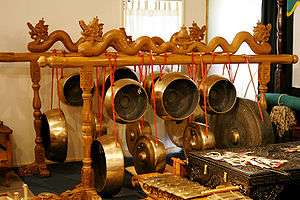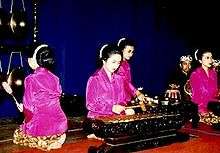Gamelan degung
| Music of Indonesia | |
|---|---|
 Kempul gongs from Java | |
| Genres | |
| |
| Specific forms | |
| Regional music | |
Gamelan Degung is a Sundanese musical ensemble that uses a subset of modified gamelan instruments with a particular mode of pelog scale. The instruments are manufactured under local conditions in towns in West Java such as Bogor.[1] Degung music is often played at public gatherings in West Java, such as at local elections, as well as many other events.[2] There is international interest in degung as well amongst communities in other countries interested in Indonesia and gamelan music.[3]
Instruments

Closeup of a gong from gamelan degung
The instrumentation of gamelan degung is quite flexible. It may include:
- Bonang/kolènang: two rows of seven small bulbous gongs. It differs from its Javanese counterpart in that the rows are each placed on either side of the player.
- Saron/peking: a high-pitched bronze metallophone with fourteen keys.
- Panerus: another bronze metallophone, similar to the peking but pitched an octave lower.
- Jengglong: six bulbous gongs suspended from the same frame.
- Goong ageung: a large gong.
- A set of kendang, consisting of one large and two small double-sided drums.
- Suling degung: a four-holed bamboo flute.
- Gambang: a wooden xylophone.

Sundanese Gamelan Degung.

Sundanese students playing gamelan degung on the street.
In classical degung, the bonang serves as a conductor for the whole ensemble. Except in certain modern compositions, it is rarely absent.
References
- ↑ Retno K. Djojo, 'For the love of music', The Jakarta Post, 29 January 2010.
- ↑ Theresia Sufa, 'Sundanese music and dance liven election day in Bogor', The Jakarta Post, 26 October 2008.
- ↑ Dewi Anggraeni, 'Melbourne: Gamelan, elephants and 'Jackpot', The Jakarta Post, 22 February 2004.
This article is issued from
Wikipedia.
The text is licensed under Creative Commons - Attribution - Sharealike.
Additional terms may apply for the media files.

